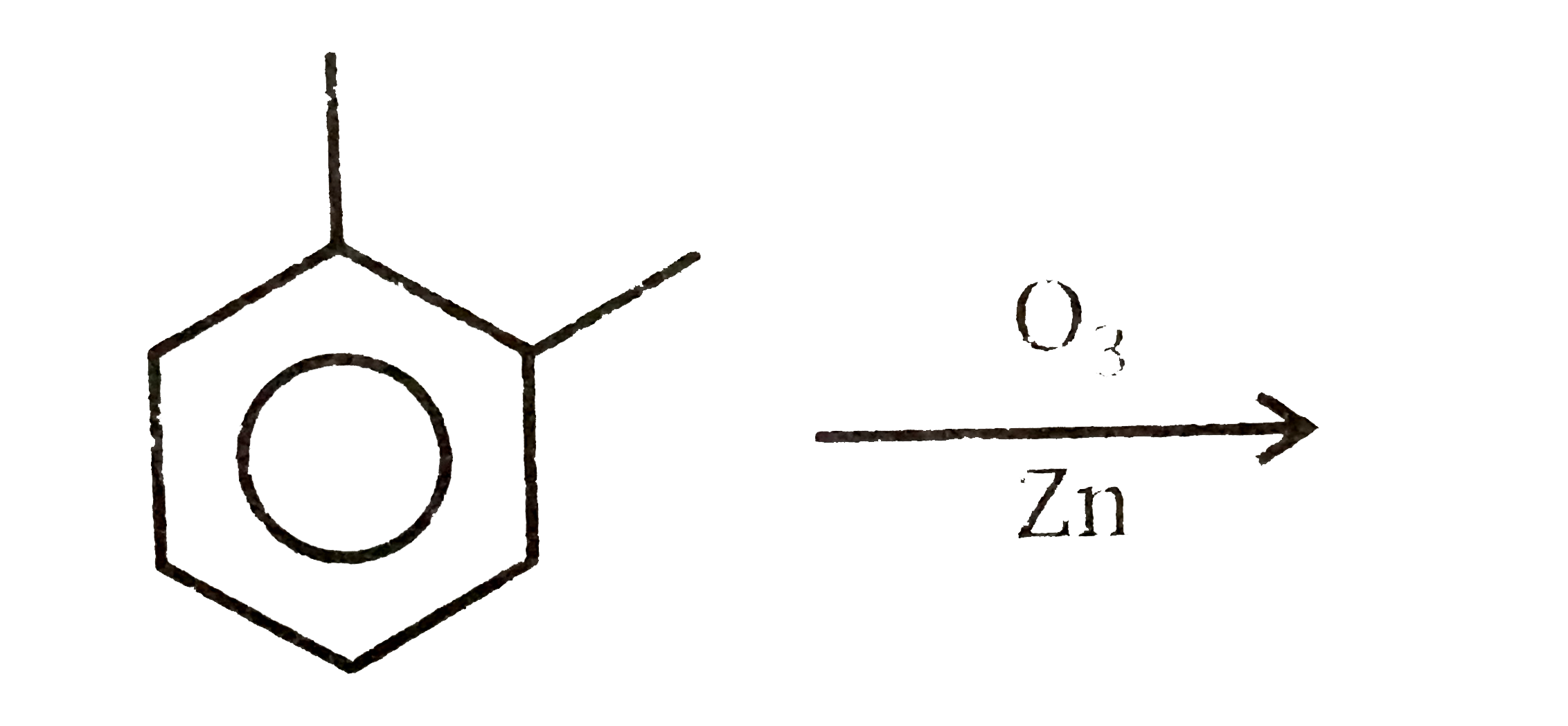Write down the products of ozonolysis of 1, 2-dimethylbenzene (o-xylene). How does the result support Kekulé structure for benzene?
The correct Answer is:CH3−C=O CH3−C=O CHO | | and ∣CH3−C=OH− C=O CHO
All the htree product connot be obtained by any one of the kekule's structures. This show that benzene is a resonance hybrid of the two resonating structures.
To solve the problem of determining the products of ozonolysis of 1,2-dimethylbenzene (o-xylene) and how the result supports the Kekulé structure for benzene, we can follow these steps:
Step 1: Understand the Structure of o-Xylene
1,2-Dimethylbenzene, commonly known as o-xylene, has a benzene ring with two methyl groups attached to adjacent carbon atoms (the ortho position). The structure can be represented as follows:
CH3|C6H4−C|CH3
Step 2: Ozonolysis Reaction
Ozonolysis involves the reaction of an alkene with ozone (O3), followed by reduction. In the case of o-xylene, the double bonds in the benzene ring are not directly involved in ozonolysis; instead, the reaction will cleave the carbon-carbon bonds adjacent to the methyl groups.
Step 3: Predict the Products
When o-xylene undergoes ozonolysis, the following products are formed:
1. Methylglyoxal (CH3C(=O)CHO): This compound results from the cleavage of the carbon-carbon bond between one of the methyl groups and the adjacent carbon in the benzene ring.
2. Glyoxal (C2H2O2 or O=CH-CHO): This compound is formed from the cleavage of the carbon-carbon bond adjacent to the other methyl group.
Thus, the products of ozonolysis of o-xylene are:
- Methylglyoxal (CH3C(=O)CHO)
- Glyoxal (O=CH-CHO)
Step 4: Analyze the Resonance Structures
The presence of two distinct products (methylglyoxal and glyoxal) indicates that the structure of o-xylene is not fixed but rather a resonance hybrid of two structures. The two resonance structures can be drawn as follows:
1. Resonance Structure 1:
- Methyl groups at positions 1 and 2 with alternating double bonds.
2. Resonance Structure 2:
- Methyl groups at positions 1 and 2 with the double bonds shifted.
Step 5: Conclusion on Kekulé Structure
The formation of two different products from the ozonolysis of o-xylene supports the idea that the benzene ring can be represented as a resonance hybrid of multiple structures (Kekulé structures). If benzene were to have a fixed structure, we would expect only one product from the ozonolysis. However, the presence of multiple products indicates that the actual structure of benzene is a hybrid of these resonance forms, thus supporting Kekulé's model.
Summary of Products
- Methylglyoxal (CH3C(=O)CHO)
- Glyoxal (O=CH-CHO)
1,2-Dimethylbenzene, commonly known as o-xylene, has a benzene ring with two methyl groups attached to adjacent carbon atoms (the ortho position). The structure can be represented as follows:
Ozonolysis involves the reaction of an alkene with ozone (O3), followed by reduction. In the case of o-xylene, the double bonds in the benzene ring are not directly involved in ozonolysis; instead, the reaction will cleave the carbon-carbon bonds adjacent to the methyl groups.
When o-xylene undergoes ozonolysis, the following products are formed:
1. Methylglyoxal (CH3C(=O)CHO): This compound results from the cleavage of the carbon-carbon bond between one of the methyl groups and the adjacent carbon in the benzene ring.
2. Glyoxal (C2H2O2 or O=CH-CHO): This compound is formed from the cleavage of the carbon-carbon bond adjacent to the other methyl group.
- Methylglyoxal (CH3C(=O)CHO)
- Glyoxal (O=CH-CHO)
The presence of two distinct products (methylglyoxal and glyoxal) indicates that the structure of o-xylene is not fixed but rather a resonance hybrid of two structures. The two resonance structures can be drawn as follows:
- Methyl groups at positions 1 and 2 with alternating double bonds.
2. Resonance Structure 2:
- Methyl groups at positions 1 and 2 with the double bonds shifted.
The formation of two different products from the ozonolysis of o-xylene supports the idea that the benzene ring can be represented as a resonance hybrid of multiple structures (Kekulé structures). If benzene were to have a fixed structure, we would expect only one product from the ozonolysis. However, the presence of multiple products indicates that the actual structure of benzene is a hybrid of these resonance forms, thus supporting Kekulé's model.
- Methylglyoxal (CH3C(=O)CHO)
- Glyoxal (O=CH-CHO)
Topper's Solved these Questions
Similar Questions
Knowledge Check
- Question 1 - Select One
The products obtained by the ozonolysis of 2-ethyl but-1-ene are:
Aethanol and propanoneBethanal and butanalCethanal and 3-pentanoneDmethanal and 3-pentanone - Question 2 - Select One
Ozonolysis of o-xylene (1,2-dimethylbenzene) gives_____different products.
AtwoBfourCthreeDjust one - Question 3 - Select One
The IUPAC name of the products obtained by the ozonolysis of 2-ethyl but-1-ene are
APropanal and EthanalBButan-2-one and EthanalCPentan-3-one and MethanalDNone of these
Write IUPAC names of the products obtained by the ozonolysis of the 2-ethylbut-1-ene compound.
View SolutionWrite IUPAC names of the products obtained by the ozonolysis of the 1-phenylbut-1-ene compound.
View SolutionGive the products of reductive and oxidative ozonolysis of toluene ando−,m−,and p−xylenes.
View SolutionHow many products will form by reductive ozonolysis of ortho−xylene :
View Solution
Which of the following products cannot be obtained in ozonolysis of o-xylene?View Solution
